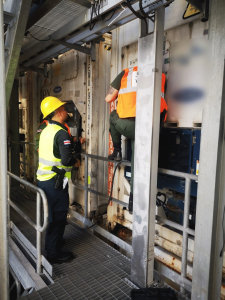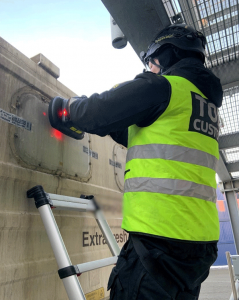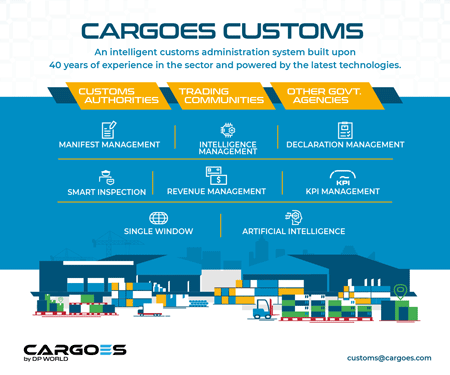Combating the infiltration of criminals in the maritime supply chain: an overview of Operation TIN CAN
18 October 2023
By the WCO SecretariatOperation TIN CAN was the first enforcement activity actively involving the shipping industry to combat the contamination of legitimate cargo with drugs through the rip-on/rip-off method. This article explains how it opened new horizons for enhancing the capacity of Customs to fight drug smuggling, especially through enhanced cooperation with shipping lines and the use of various technologies.
Most of the cocaine seized by Customs administrations is found on ships and other vessels. Cocaine is shipped directly from the countries of production, but also from neighbouring countries in South and Central America, as well as the Caribbean.
There are many ways drugs shipments can be concealed aboard ships. One of them is to put them in a container. This can be done by camouflaging the drug within the load, which requires traffickers to run front companies. It can also be done by breaking open containers, loading packages or bags of drugs inside them, and then using duplicate or cloned Customs seals to conceal the tampering.
This last method is called the rip-on/rip-off method. The drug is placed in the front of the container in bags, in the reefer compartment or in the structure of the container, or with the legitimate cargo. It requires traffickers to work with “insiders”, who use their authorized access, deliberately or under coercion, to manage the logistics process. Some will transport the drug into the port, whilst others will access and move containers, or share information on which container has been scanned, as well as on the container’s location,[1] from the departure country, through transit countries, to the final destination where the drugs will be retrieved and taken out of the port.
We are not talking about “small” quantities. In 2020, police in Costa Rica made the biggest seizure of drugs in the country’s history, finding more than five tons of cocaine in 202 suitcases which had been placed in a container with a consignment of flowers headed for the Netherlands. This is just one of many examples.
The use of the rip-on/rip-off method is not a new phenomenon but, until a few years ago, many countries still believed that such an infiltration could not happen in their ports. However, several incidents and a huge increase in the number of reported drug smuggling attempts using the method have put the issue under the spotlight in more and more countries. Since 2011, seizure data has shown that the rip-on/rip-off method has been increasingly used to move cocaine, and the insider threat has become a major concern for both Customs and law enforcement agencies, as well as for shipping lines. The latter are losing money when drug shipments are discovered, as ships and containers may be detained for weeks, and crew members are investigated and sometimes arrested. Reputational damage is another concern, as well as staff security.
Targeting methods to identify “contaminated” containers are primarily based on analysing container routing and data received from shipping lines. Security guards on the ships inspect containers while they are out at sea. Some liners have also invested in technology to monitor container-related activities on their ships and at terminals. They have, however, no direct communication mechanism with Customs authorities, and no legal framework covering, for example, data protection and confidentiality safeguards. In addition, there is a lack of formal communication channel between the parties.
To discuss ways to collaborate and to open lines of communication, representatives of shipping companies and Customs authorities from various regions came together at the WCO Headquarters in June 2022 at a Conference organized by the World Shipping Council (WSC) and the Container Control Programme (CCP), which is a joint initiative between the UN Office on Drugs and Crime (UNODC) and the WCO. A few months later, in partnership with ONODC, the WCO Secretariat organized an enforcement operation during which all these actors were to establish data exchange mechanisms with the objective of disrupting cocaine trafficking using the rip-on/rip-off methodology. The Australian Border Force provided significant support for the Operation.
Operation TIN CAN
Named TIN CAN, the Operation ran for four weeks at the end of 2022, with 58 Customs administrations participating, as well as five major shipping lines, including all those operating in Latin America, and a company offering roll-on/roll-off shipping services (in other words, cargo ships designed to carry wheeled cargo, such as cars, motorcycles, trucks, semi-trailer trucks, buses, trailers, and railroad cars, that are driven on and off the ship).

Training material was provided to participating administrations. It included the United States Customs and Border Protection Service training on “Seal Security”, as well as the UNODC-WCO Container Control Programme training on the “Insider Threat” and rip-on/rip-off modus operandi.
An Operational Coordination Unit (OCU) was set up at the WCO Headquarters, with the task of collecting seizure data from Customs administrations (including the CCP Port Control Units) and from other information sources, so as to provide all participants with a comprehensive overview of smuggling methods and accurate risk indicators.
The unit also received information from participating shipping lines and communicated it to the administrations concerned, which then assessed the need for a control. Shipping lines were also provided with a central contact point for their referrals in each participating administration.
Shipping lines were to inform the OCU and the contact points about specific incidents or events, such as unusual requests to “switch the BL”, change the destination port of the BL or other data, cancellations of export bookings, unusual changes in temperature for reefer containers (a specialized container that carries temperature-sensitive goods at regulated cold temperatures), or any other information they considered risk criteria.
A total of 688 alerts were received in the OCU from the shipping lines. Some of these alerts resulted in cases. 158 cases were reported by Customs administrations and police services, representing a total of 98,734 kg of cocaine and 314 kg of marijuana. In 107 cases, representing 62,834 kg of cocaine, the rip-on/rip-off method was used. 25 seizures were made in containers in transshipment, and for 22 of these seizures, the rip-on method was used.
It is worth noting that other modi operandi require an insider-job, and during the Operation, some drugs were found concealed under water in a ship’s sea chest, and inside bulk carriers, as well as floating in the Pacific Ocean. 43 individuals, exploited either wittingly (often through threats to their own or their family’s safety) or unwittingly by criminal organized groups, were arrested.
Testing technology
Drugs used to be found mainly inside bags near the door of the container and were therefore visible once it was opened. Nowadays, however, they are more likely to be found behind the first rows of boxes or pallets of legal cargo, which makes control more difficult. One of the objectives of the Operation was to test and identify effective detection and control technologies to determine the presence of drugs. As with all emerging technologies, the use of smart container alerts cannot be relied upon in isolation, but can be used in support of other targeting techniques.
Vapour detection
Belgium Customs in the port of Antwerp tested devices enabling vapour screening using swab and air samplings. The air sampling device works as follows: a small tube, which contains a sample trap, is inserted through the container door gasket or is fixed over the ventilation outlet; it extracts the air from the container into the sample trap, where volatiles from the air are collected on a sample card; the sample card is then transferred to an analyser, which compares the molecules present against a library. With swab sampling, special gloves made of natural wool are used to collect the volatiles which have settled on the surface of the cargo.
Vapour screening proved to be a rapid and reliable non-intrusive inspection technology during the trial. Out of the 33 containers which were tested, five containers were found to be positive and 28 containers were found to be negative. Further physical inspection confirmed the results.
The containers had also passed through X-ray scanning. Two of the containers which were found to contain cocaine showed no anomalies on the image. One was transporting boxes of cassava roots, and the bricks of cocaine were found in a few boxes wrapped in plastic and concealed underneath the cassava.
Door opening detection devices
Two shipping lines participating in the Operation used containers with permanently affixed devices providing real-time location and detecting door openings, thanks to sensors sensitive to light, shock and temperature changes. Data was collected on an online platform and algorithms were used to identify unexpected door openings. Prior to the start of the Operation, the shipping lines positioned these containers at ports considered as high-risk by the industry throughout Latin America, and provided the OCU with remote access to their alert platform for the entire duration of the Operation. The alerts were jointly triaged by the OCU and the referring shipping line to assess the required operational response.
Some factors limited the efficiency of the technology. Some countries regulate, restrict and/or prohibit the importation of devices affixed to containers, or do not allow such technology to be used as long as the container is in their territory. Moreover, alerts were sometimes triggered due to legitimate door openings, including by enforcement agencies which do not always inform shipping lines when they conduct inspections. The algorithms could perform better if authorities were to provide feedback on controls and share risk indicators. For example, shipping lines do not consider that empty containers or containers in transshipment pose a risk.
Reporting container movements
Some shippers are also using geofencing tools using positioning technologies to receive alerts when a vehicle enters or leaves a zone unexpectedly, or when a container movement does not make sense.
Although the OCU did not have the resources to digest the significant amounts of data generated, post-operation analysis identified the benefits of measuring:
– the average transit time of containers transported by truck between terminals to identify excessive transit times,
– the average dwell time of containers in high-risk ports to identify dwell time anomalies.
Smart seals
Criminal organizations can clone and reconstruct bolt container seals. Various types of technology exist to ensure seal integrity. Two were tested during the Operation: electronic seals, which enable the detection both of seal tampering and container door openings via a specially designed latch mechanism that transmits alerts to a software application; and Radio-Frequency Identification (RFID) seals, which look like regular bolt seals and which require officers to scan a Quick Response (QR) code to confirm if the seal is legitimate.

What we learned
Lessons learned are as follows:
- Analysis of seizures indicates that ports and terminals deemed as high-risk for cocaine smuggling are not always the ones where a rip-on occurs, and transshipment operations are especially risky. Moreover, cocaine is not the only drug concerned and the method has also been used to move methamphetamine and cannabis.
- Identifying contaminated containers and identifying the presence of drugs in those containers requires the use of various techniques and technologies, including access to those used by the industry.
- Industry needs to understand Customs targeting techniques and to receive information from law enforcement to enhance the quality and accuracy of their alerts.
- Customs needs to understand how shippers operate and the technology they use to target and monitor illicit activities.
- Participating administrations need to strengthen their reporting capacities in order to be able to provide detailed and complete information.
- If shipping lines were to send referrals to Customs administrations, the latter would need to organize and facilitate collection of the data and to develop capacities to analyse the data.
Way forward
During the Operation planning phase, when trying to identify red flag indicators, a clear gap was identified between industry and Customs. What seemed like a normal business practice for one party was sometimes a risk indicator for the other. The World Shipping Council, through their Safety and Security Group, decided to develop training on the examination of shipping documentation and supply chain processes to close this gap. The contents of the training are to be determined in collaboration with Customs administrations and the WCO. Shipping lines seem to be rapidly upgrading entire fleets of containers with varying technical capabilities. It is imperative for Customs administrations to establish communication lines with these actors and to build capacity to leverage the data they provide. The WCO Secretariat will continue to foster such cooperation and is exploring ways to enable efficient data sharing with private sector entities.
A symposium on “Insider Threats” is under consideration, the idea being to bring together representatives from Customs, the police, prosecutor offices, shipping industry and other transporters to discuss how to enhance procedures and communication. The WCO Secretariat will also organize regular meetings with private sector representatives to take stock of developments. Finally, another edition of Operation TIN CAN is in the pipeline, as well as a study of the way criminal organizations use threats and money to corrupt individuals.
More information
enforcement@wcoomd.org
[1] According to various sources, criminals are using tracking devices to monitor their shipments and to be kept informed if Customs has examined and detected the illicit goods (https://www.tradewindsnews.com/law/rip-on-rip-off-alert-no-port-safe-after-drug-gangs-up-their-game/2-1-1457380 or https://www.foxnews.com/us/drug-cartels-heavily-rely-on-gps-devices-to-track-shipments-feds-say)

